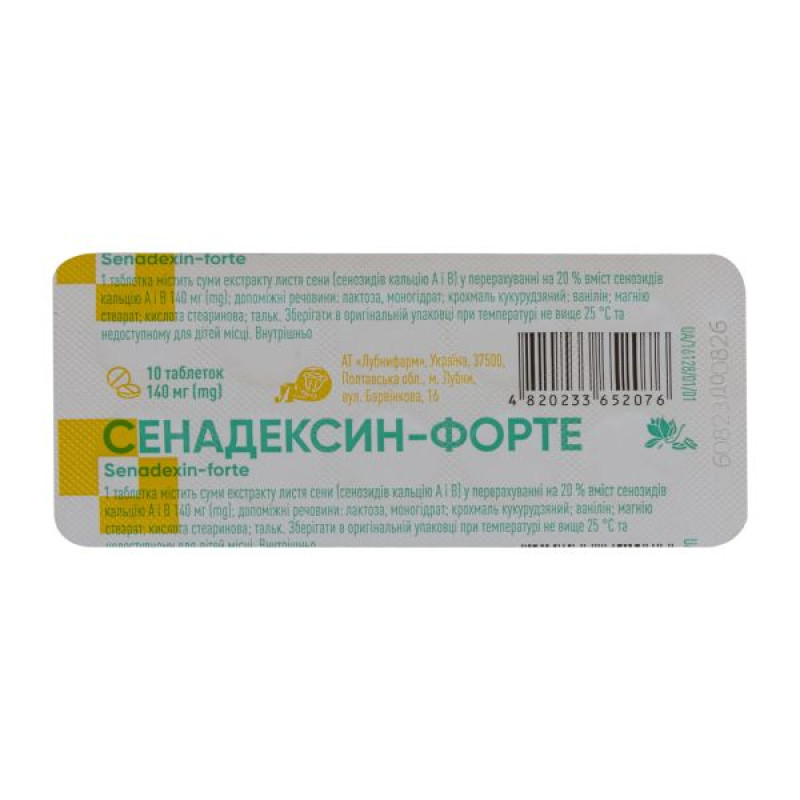Senadexin-forte tablets 140 mg No. 10

Instructions for use Senadexin-forte tablets 140 mg No. 10
Composition
active ingredient: sum of senna leaf extract (calcium sennosides A and B);
1 tablet contains the amount of senna leaf extract (calcium sennosides A and B) calculated as 20% calcium sennosides A and B content 140 mg;
excipients: lactose monohydrate; corn starch; vanillin; magnesium stearate; stearic acid; talc.
Dosage form
Pills.
Main physicochemical properties: solid, regular, round cylinders, the upper and lower surfaces of which are flat, the edges of the surfaces are beveled, there is a dividing line, from light brown to dark brown with specks, with the smell of vanillin.
Pharmacotherapeutic group
Contact laxatives. Senna glycosides. ATX code A06A B06.
Pharmacological properties
Pharmacodynamics. A laxative drug of plant origin (senna leaf, or Alexandrian leaf, or cassia leaf) that acts on the motility of the large intestine.
The pharmacological action is due to anthraglycosides (mainly sennosides A and B), as well as other glycosides. When administered orally, senna glycosides pass through the stomach and small intestine unchanged, without being absorbed. In the large intestine, anthraglycosides are broken down by intestinal bacteria into pharmacologically active anthrones and anthranols, which, by irritating the interoreceptors of the large intestine, increase peristalsis and accelerate bowel emptying. Anthrones and anthranols prevent the absorption of water and electrolytes, promote the diffusion of water into the intestinal lumen. As a result of the osmotic effect, there is an increase in the volume of fecal masses, an increase in filling pressure, which contributes to the stimulation of peristalsis.
The laxative effect is manifested after 6–12 hours. With prolonged use of the drug, the intensity of its action may decrease due to a decrease in the potassium content in the body.
Pharmacokinetics. The active substances - metabolites of senna anthraglycosides - are practically not absorbed, are mainly excreted with feces and urine. They are also excreted with sweat, a small amount of them enters breast milk.
Indication
Constipation caused by intestinal atony of various etiologies.
Preparation for X-ray examinations.
Contraindication
Increased individual sensitivity to the active substance and/or to other components of the drug. Nausea, vomiting, acute inflammatory diseases of the digestive tract (Crohn's disease, colitis, ulcerative colitis), undiagnosed diseases of the digestive tract, which may be the result of acute intestinal diseases or surgical interventions (diverticulitis, appendicitis, peritonitis, frequent diarrhea), intestinal obstruction / paralytic intestinal obstruction, spastic constipation, strangulated hernia, gastrointestinal and uterine bleeding, cystitis, epigastric pain of unknown origin, spastic pain, organic liver damage, severe disorders of water-salt balance (hypokalemia), rectal hemorrhage.
Interaction with other medicinal products and other types of interactions
To date, no cases of clinically significant drug interactions have been reported.
A decrease in the level of active substances in the blood serum is possible with simultaneous use of quinidine sulfate (an antiarrhythmic drug) due to competing properties with anthraquinone laxatives. Simultaneous use with cardiac glycosides due to hypokalemia can cause cardiac arrhythmia. With simultaneous use of antiarrhythmic drugs, diuretics and corticosteroids, muscle weakness develops. With prolonged use or use in high doses, the drug disrupts the absorption of tetracyclines. Reduces the effectiveness of drugs that are slowly absorbed in the digestive tract.
It is also necessary to consider the medications that the patient has taken recently.
Application features
The drug is recommended to be used only when normalization of bowel movements cannot be achieved by changing the diet; the minimum effective dose necessary to restore normal bowel function should be taken.
Patients taking cardiac glycosides, antiarrhythmics, drugs that increase the QT interval, diuretics, corticosteroids, or licorice root preparations should consult a doctor before using the drug.
If the cause of constipation is unknown or there are complaints of other digestive tract disorders (abdominal pain, nausea and vomiting), then before starting to take laxatives, it is necessary for the doctor to establish the cause of constipation, as these symptoms may be signs of the development or presence of intestinal obstruction.
The drug is intended for occasional use. Therefore, if the drug is taken for more than 1 week, caution and prior consultation with a doctor are required, since prolonged use of laxatives that stimulate intestinal activity may lead to increased intestinal atony.
The drug should not be used within 2 hours of taking other medications or in doses exceeding the recommended ones.
The drug should be used with caution in patients with liver or kidney disease, or chronic inflammatory bowel disease.
The medicinal product contains lactose, which should be taken into account in patients with rare hereditary forms of lactose intolerance, lactase deficiency, or glucose-galactose malabsorption syndrome.
Use during pregnancy or breastfeeding
Although the use of the drug in pregnant women is not contraindicated, it is recommended to use it only under the supervision of a doctor. The use of the drug in pregnant women is associated with a higher likelihood of developing side effects (abdominal pain, diarrhea).
It is recommended to stop breastfeeding during treatment, as the components of the drug can penetrate into breast milk and cause frequent loose stools in the child. At the same time, with proper dosage, the occurrence of undesirable effects in the child is unlikely.
Ability to influence reaction speed when driving vehicles or other mechanisms
The drug usually does not affect the ability to drive vehicles and perform work that requires increased attention, speed of mental and motor reactions. However, it is necessary to check the individual reaction to the drug.
Method of administration and doses
The medicine is taken orally with a small amount of liquid, usually before bedtime or in the morning.
Adults and children over 12 years of age are recommended to take 1 tablet 1–2 times a day. The maximum daily dose is 2 tablets.
Elderly patients should start treatment with a dose of 1/2 tablet.
The drug is intended for short-term treatment.
Children.
Not recommended for use in children under 12 years of age.
Overdose
Overdose may cause diarrhea, which may be accompanied in some cases by severe intestinal irritation, causing water-salt imbalance, loss of water and electrolytes, intestinal colic, irritation of the digestive tract, nausea, epigastric pain, cramps, impaired intestinal function, vascular collapse and metabolic acidosis. Electrolyte levels, in particular potassium, should be monitored. This is important for elderly patients. Continuous administration of large doses can lead to toxic hepatitis. Overdose may cause colicky abdominal pain, dyspepsia, requiring discontinuation of the drug. The use of large doses can cause atrophy of the smooth muscles of the colon and disruption of its innervation.
Treatment is symptomatic, including gastric lavage. If there is a risk of severe diarrhea, rehydration (taking plenty of water) is recommended.
Side effects
The drug is usually well tolerated, but side effects are rare, which are usually reversible and quickly disappear after stopping the drug or reducing its dose.
Gastrointestinal tract: in rare cases, anorexia, complaints of spastic abdominal pain, diarrhea are possible; with prolonged use - nausea, vomiting, flatulence, intestinal pseudomelanosis, colonic atony, indigestion, colic, weight loss. With prolonged use/abuse of laxatives, pigment deposition in the intestinal mucosa (pseudomelanosis) is possible, which is safe and, as a rule, disappears after discontinuation of the drug.
On the part of the kidneys and urinary system: change in urine color (red or brown depending on the pH, which has no clinical significance); with prolonged use/abuse - proteinuria, hematuria, hyperaldosteronism, hypocalcemia.
Metabolism and metabolism: prolonged use of laxatives can lead to loss of electrolytes, mainly potassium, which can cause cardiac dysfunction, especially when used simultaneously with cardiac glycosides, diuretics and adrenal cortex hormones, fatigue, muscle weakness, convulsions, collapse.
Immune system disorders: allergic reactions (including skin rash, itching, urticaria, local or generalized exanthema).
In case of any reaction, you should consult a doctor regarding further use of the medicine.
Expiration date
3 years.
Storage conditions
Store in the original packaging at a temperature not exceeding 25 °C.
Keep out of reach of children.
Packaging
10 tablets in a blister, 2 blisters or 10 blisters in a pack.
Vacation category
Without a prescription: tablets No. 10, No. 20 (10×2).
Prescription: tablets No. 100 (10×10).
Producer
JSC "Lubnypharm".
Location of the manufacturer and address of its place of business.
Ukraine, 37500, Poltava region, Lubny, Barvinkova st., 16.
There are no reviews for this product.
There are no reviews for this product, be the first to leave your review.
No questions about this product, be the first and ask your question.





